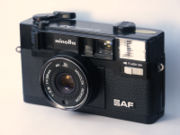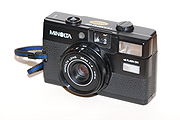
Minolta Hi-Matic
Encyclopedia




Camera
A camera is a device that records and stores images. These images may be still photographs or moving images such as videos or movies. The term camera comes from the camera obscura , an early mechanism for projecting images...
s made by Minolta
Minolta
Minolta Co., Ltd. was a Japanese worldwide manufacturer of cameras, camera accessories, photocopiers, fax machines, and laser printers. Minolta was founded in Osaka, Japan, in 1928 as . It is perhaps best known for making the first integrated autofocus 35mm SLR camera system...
. The original Hi-Matic of 1962 was the first Minolta camera to feature automatic exposure and achieved a small degree of fame when a version (the Ansco
Ansco
Ansco was the name of a photographic company based in Binghamton, New York, which produced inexpensive cameras for most of the 20th century. It also sold rebadged versions of cameras made by other manufacturers, including Agfa and Chinon...
Autoset) was taken into space by John Glenn
John Glenn
John Herschel Glenn, Jr. is a former United States Marine Corps pilot, astronaut, and United States senator who was the first American to orbit the Earth and the third American in space. Glenn was a Marine Corps fighter pilot before joining NASA's Mercury program as a member of NASA's original...
in 1962.
Models
The first Hi-Matic, introduced in 1962, was offered with a 45 mm f/2 or 45 mm f/2.8 lensPhotographic lens
A camera lens is an optical lens or assembly of lenses used in conjunction with a camera body and mechanism to make images of objects either on photographic film or on other media capable of storing an image chemically or electronically.While in principle a simple convex lens will suffice, in...
and featured a built-in selenium
Selenium
Selenium is a chemical element with atomic number 34, chemical symbol Se, and an atomic mass of 78.96. It is a nonmetal, whose properties are intermediate between those of adjacent chalcogen elements sulfur and tellurium...
light meter
Light meter
A light meter is a device used to measure the amount of light. In photography, a light meter is often used to determine the proper exposure for a photograph...
and rangefinder. Both the aperture
Aperture
In optics, an aperture is a hole or an opening through which light travels. More specifically, the aperture of an optical system is the opening that determines the cone angle of a bundle of rays that come to a focus in the image plane. The aperture determines how collimated the admitted rays are,...
and shutter speed
Shutter speed
In photography, shutter speed is a common term used to discuss exposure time, the effective length of time a camera's shutter is open....
were set automatically. The Hi-Matic was also rebadged as the Ansco
Ansco
Ansco was the name of a photographic company based in Binghamton, New York, which produced inexpensive cameras for most of the 20th century. It also sold rebadged versions of cameras made by other manufacturers, including Agfa and Chinon...
Autoset.
The Hi-Matic 7 followed in 1963. It had a faster f/1.8 lens and used a CdS cell instead of a selenium meter. Additionally, it gave photographers the option of setting the exposure manually, an option not available in the original Hi-Matic. The Hi-Matic 7S and Hi-Matic 9, both released in 1966, were slightly improved versions of the popular 7. The 9 was the same as the 7S with the addition of a slightly faster f/1.7 lens. The Hi-Matic 11 of 1969 was a version of the 9 with no manual controls.
In 1969 Minolta came out with a new, smaller model, the Hi-Matic C. In the interest of compactness, it had a smaller 40 mm f/2.7 lens (which was collapsible), reduced aperture and shutter speed ranges, and no longer featured a rangefinder. The C had shutter-priority automatic exposure with a CdS meter. The Hi-Matic 5, also released in 1969, was basically a less expensive C without the collapsing lens.
The Hi-Matic E of 1971 was a much-improved version of the C with a 40 mm f/1.7 lens and a rangefinder. It used the same Electro Control automatic exposure system found on the Yashica Electro
Yashica Electro 35
The Electro 35 is a rangefinder camera made by Japanese company Yashica from the mid-1960s with a coupled and fixed 1:1.7 45 mm lens. It was the first electronically controlled camera, operating mainly in an aperture priority 'auto' mode. The only other modes of operation are 'flash' and 'bulb'.-...
cameras. The E was followed by a succession of increasingly inexpensive models, the Hi-Matic F in 1972, the Hi-Matic G in 1974, and the Hi-Matic G2 in 1982. The Electro Control system was abandoned after the F in favor of a simpler system.
The next Hi-Matic model, which was called the Hi-Matic 7 SII and came out in 1977, was considered to be one of the finest Minolta rangefinders. It featured a 40 mm f/1.7 lens and shutter priority automatic exposure in addition to manual controls, all in a compact package.
A built in electronic flash came to the series for the first time in 1978 with the Hi-Matic S. It was a fully automatic (except for focusing) camera equipped with a Rokkor 38 mm f/2.7 lens. There were several variants, including the Hi-Matic SD (date back), the Hi-Matic S2 (slightly slower lens), and the Hi-Matic SD2 (S2 with a date back). Focusing was automated in 1979 with the introduction of the Hi-Matic AF, which was essentially an S2 with the addition of autofocus
Autofocus
An autofocus optical system uses a sensor, a control system and a motor to focus fully automatic or on a manually selected point or area. An electronic rangefinder has a display instead of the motor; the adjustment of the optical system has to be done manually until indication...
.
The last Hi-Matic was the Hi-Matic GF of 1984, a very simple and cheap plastic model which was not sold in the United States. It had a 38mm f/4 lens that allowed to choose between three predefined apertures denoted by beginner friendly icons: sunny, partly cloudy and cloudy. Focusing was manual and set in four steps from about 1 m to infinite.

